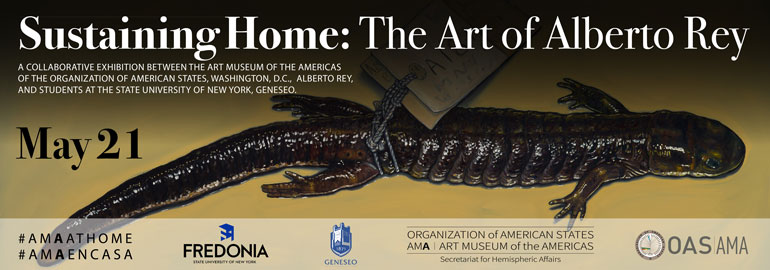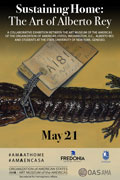
Sarah Guadagna is a Junior at SUNY Geneseo majoring in Art History, with a strong interest in art and literature.
On social media May 26, 2021
Las Balsas—1995-97
by Sarah Guadagna
The works that I have chosen for this exhibition come from Alberto Rey’s Las Balsas Artifacts Series (The Rafts Artifacts Series), wherein Rey presents a series of rafts Rey encountered on a trip to Key West, which were on exhibition at the Refugee Transit Center on Stock Island, near Key West. The exhibition was composed of the actual rafts on which Cubans, seeking asylum in the United States, began to travel the 90 mile journey across the Caribbean Sea, starting in the 1980s. The preserved rafts did not come with histories of the fortunes of their occupants and it was their anonymity that caught Rey’s attention, along with the hidden stories they conveyed. Rey’s painting of the rafts appears on a wooden background that forms the front of boxes Rey builds out of wood. Within each image of the rafts composing this series, the overall tone and presence of the rafts as objects gives the spectator an overwhelming feeling of compassion for the unseen subjects, who set out on the actual rafts that Rey chronicled. Each painting, in Rey’s series, portrays a snapshot of somebody’s life story and transports those who look at his depictions into the reality of those who set out in the rafts, reaching a fate that will remain unknown to us. Of the series, three works caught my attention and I will be examining Rey’s Caridad Del Cobre, Cross Rosary and Keys and Baby Bottle, Child’s Shoes, Air Pump, and Hat, with the goal of discussing their overall humanity, their emotional tone, and the circumstances of their creation.
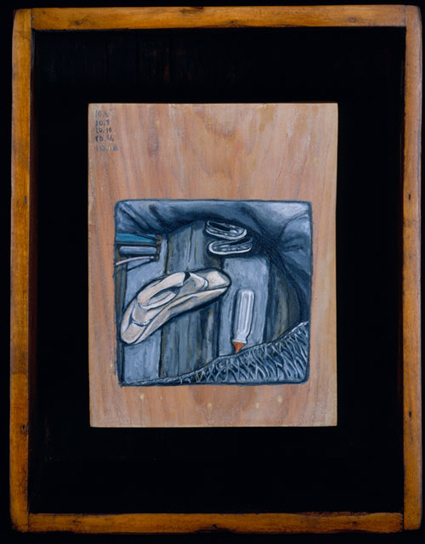
Las Balsas Artifacts: Baby Bottle Childs, Shoes, Air Pump, and Hat, 1995-1999, Oil on Wood, 8” x 10” x 4.5”
Alberto Rey’s Las Balsas Artifacts: Baby Bottle, Child’s Shoes Air Pump, and Hat is uniquely evocative of the fate of the balseros, the rafters, who used boats and rafts assembled out of found objects to traverse the Caribbean Sea to the shores of Florida. The depicted scene evokes the rush of departure and the feeling of things taken and things left behind. The painting shows items such as a baby bottle and a hat that were left behind on the abandoned rafts, possibly after their inhabitants were rescued or are they the remains of a human tragedy? The emotional quality of the paintings draws in the spectator with such a strong feeling of connection to the people that we will never see or whose fate we will never know in a way that personal and compassionate. Even the name of the work fits the circumstances that were captured in the scene, as the inventory of objects are not associated with specific individuals and they become generically representative of the exodus and unknown fate of the balseros. Rey’s use of simply stating what is in the raft lets the spectator create their own narrative in a participatory manner and it is this act of empathy that Rey’s series best succeeds in narrowing the gap between artist, subject and audience.
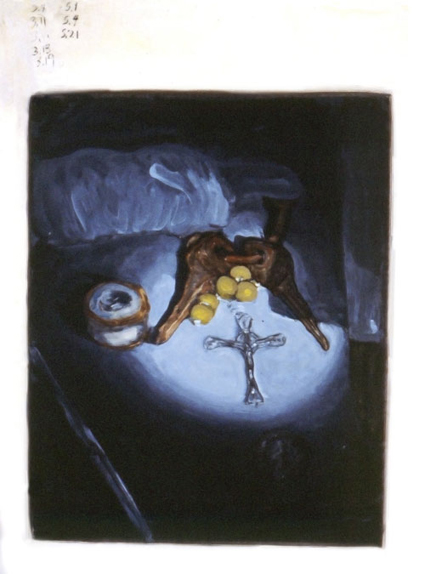
Las Balsas Artifacts: Cross, Rosary and Keys, 1995-1999, Oil on Plaster, 15.5 x 12 x 4”
Within Alberto Rey’s series, “Las Balsas Artifacts,” Cross, Rosary, and Keys combines an evocative composite of elements found in other works in this series. It depicts a small cross, a set of keys and a rosary lying, as though on a table, in the style of a classical still life, reminiscent of 17th Century, Baroque painting. The represented objects form an image that implies a focus on religion and hope. As the rosary is resting on top of the keys, the vignette can be interpreted as symbolizing a new home or one left behind. In this work and throughout the “Las Balsas Artifacts Series,” Rey repeatedly employed a spotlight effect to emphasize the existence of objects, while giving them association with spiritual auras of light. In this specific work, the spotlight is very focused and intense, forcing the spectator to look at the objects found in the raft, as they meditate on their significance.
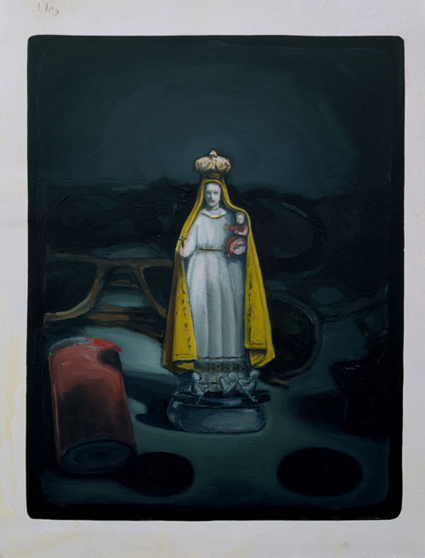
Las Balsas Artifacts: Caridad del Cobre, 1995-1999, Oil on Plaster, 15.5 x 12 x 4”
A third work in Alberto Rey’s “Las Balsas Artifacts Series,” the Caridad Del Cobre, which translates to “Our Lady of Charity of Cobre (Cuba).” Incorporated in the work are strong religious connotations similar to those evident in Rey’s Cross Rosary and Keys. Cobre is a Cuban harbor town, which was the site of the appearance of a miraculous image of the Virgin and Child, which reputedly saved three, Cuban sailors from a storm. It is the three sailors who appear underneath the Virgin Mary, where they are represented engaged in rowing a boat, even as she appears to be protecting them from the storm through which they row. Rey’s depiction of the statue of the Caridad del Cobre, places her in the center of the work, surrounded by items strewn around it, such as coins, sunglasses, and a red lighter. The spotlight effect, Rey used repeatedly in this series, once again comes into play and, in this work, it highlights the subject and provides an intense contrast to the rest of the painting, which is shadowed and dark. The implicit message is one of faith and belief that by carrying the image of the Caridad del Cobre, a safe harbor would be found for those who set out in this raft, who would be saved by the Virgin and Child as were the three sailors she rescued.
On Alberto’s Rey’s website (https://albertorey.com/), he describes this series as “minimal altarpieces” and the imagery and presentation of the scenes he painted, in the Las Balsas Artifacts Series, are attuned to his spiritual and meditative intentions. The works comprising this series highlight the heart-wrenching reality of what people have to go through for a better life and they force you to acknowledge the moment in history in which we live, connected to their experiences. The audience for Rey’s work can feel the emotion behind each individual painting, if even just a fraction of what was experienced by the unseen subjects can be intuited by a spectator, who is also a witness. These paintings are a beautifully moving way to educate people about Alberto Rey’s identity and about a part of the history of Cuba and the Unites States that defines his identity as a Cuban, an American and an artist.

